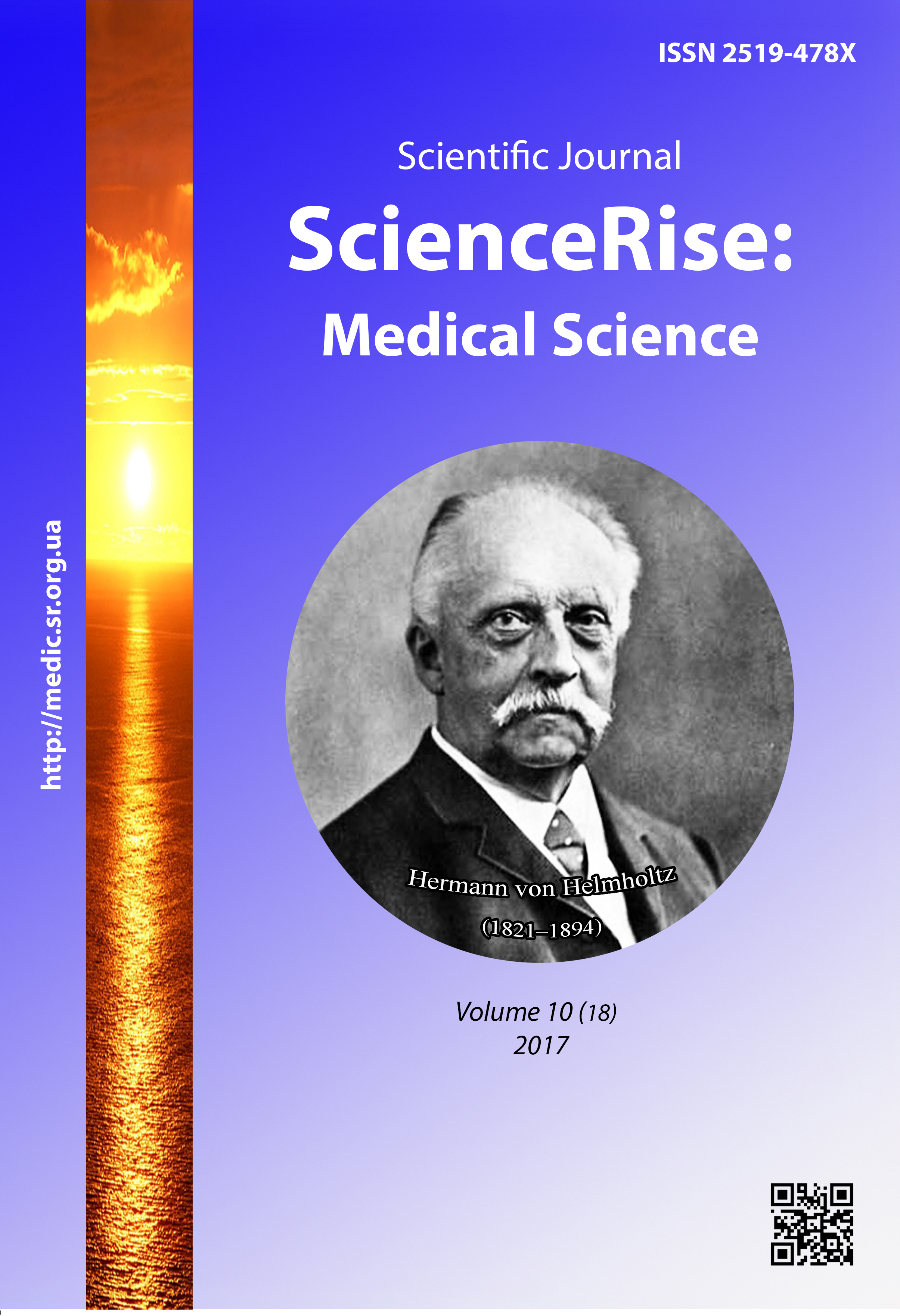Сhoice of a thrombolytic for pulmonary thromboembolism treatment
DOI:
https://doi.org/10.15587/2519-4798.2017.113324Keywords:
thromboembolism of pulmonary artery, computer tomography, Miller index, streptokinase, alteplaseAbstract
Aim of the study was to choose the optimal thrombolytic therapy for massive and submassive TEPA.
Materials and methods. 102 patients with massive and submassive embolism of lungs (Miller index > 17) were arbitrarily divided for administrating 100 mg of the recombinant tissue activator of plasminogen (r-tPA) or 3 mln of UN of streptokinase. The control multi-spiral computer tomography of breast organs (MSCT BO) or angiopulmonography (APG) was realized in 2–3 days after thrombolysis. For calculating the statistical importance of the difference of the number of patients by the concomitant pathology and sex, there was used χ2 with Ets correction. Mann-Whitney criterion was used for calculating the difference by age.
Results. There was established the advantage of using r-tPA in hemodynamically unstable patients. There was established the advantage of using streptokinase in patients with the disease duration more than 1 day. There was proved the effectiveness of repeated sessions of thrombolysis. There was established, that it’s possible to prevent hemorrhagic complications of thrombolysis if to reveal its contraindications accurately.
Conclusions. Alteplase must be used in hemodynamically unstable patients due to the faster effect comparing with streptokinase. Alteplase or streptokinase must be used for hemodynamically stable patients with massive and submassive pulmonary embolism. The repeated TLT is equally effective as thromboembolectomy at insufficient effectiveness of thrombolysis. For preventing hemorrhagic complications, the detail examination of patients is necessary to reveal possible sources of fatal bleeding and determination of contraindications to TLT
References
- Meyer, G., Vicaut, E., Danays, T., Agnelli, G., Becattini, C., Beyer-Westendorf, J. et. al. (2014). Fibrinolysis for Patients with Intermediate-Risk Pulmonary Embolism. New England Journal of Medicine, 370(15), 1402–1411. doi: 10.1056/nejmoa1302097
- Avdeev, S. N. (2009).Pulmonary embolism. Atmosphere. Pulmonology and allergology, 3, 1‒8.
- Bĕlohlávek, J., Dytrych, V.,Linhart, А. (2013).Pulmonaryembolism, part I: Epidemiology, riskfactorsandriskstratification, pathophysiology, clinicalpresentation, diagnosisandnonthromboticpulmonaryembolism. Exp. Clin. Cardiol., 18 (2), 129–138.
- Tereshchenko, S. N. (Ed.) (2010). Pulmonary embolism. Moscow: GEOTAR-Media, 96.
- Capstick, T., Henry, M. T. (2005). Efficacy of thrombolytic agents in the treatment of pulmonary embolism. European Respiratory Journal, 26 (5), 864–874. doi: 10.1183/09031936.05.00002505
- Konstantinides, S. V., Torbicki, A., Agnelli, G., Danchin, N., Fitzmaurice, D., Galiè, N. (2014). 2014 ESC Guidelines on the diagnosis and management of acute pulmonary embolism. European Heart Journal, 35 (43), 3033–3073. doi: 10.1093/eurheartj/ehu283
- Meneveau, N., Seronde, M.-F., Blonde, M.-C., Legalery, P., Didier-Petit, K., Briand, F. et. al. (2006). Management of Unsuccessful Thrombolysis in Acute Massive Pulmonary Embolism. Chest, 129 (4), 1043–1050. doi: 10.1378/chest.129.4.1043
- Krayz, I. G., Abdueva, F. M., Popova, E. I., Karpovich, D. I., Usan, N. Yu. (2012) Tactics of thrombolytic therapy in high-risk patients with pulmonary thromboembolism in the cardiological department of the Central Clinical Hospital of Kharkov. Emergency medicine, 3, 102–105.
- Parkhomenko, A. N., Irkin, O. I., Lutai, Ya. M. (2011). Thromboembolism of the pulmonary artery: algorithms for diagnosis and treatment. Emergency medicine, 3, 10–24.
- Markov, V. A., Vyshlov, E.V. (2011) Thrombolytic therapy in myocardial infarction monograph. Tomsk: STT, 148.
Downloads
Published
How to Cite
Issue
Section
License
Copyright (c) 2017 Olexander Nykonenko, Andriy Nykonenko, Serhii Matvieiev, Viacheslav Osaulenko, Serhii Nakonechny

This work is licensed under a Creative Commons Attribution 4.0 International License.
Our journal abides by the Creative Commons CC BY copyright rights and permissions for open access journals.
Authors, who are published in this journal, agree to the following conditions:
1. The authors reserve the right to authorship of the work and pass the first publication right of this work to the journal under the terms of a Creative Commons CC BY, which allows others to freely distribute the published research with the obligatory reference to the authors of the original work and the first publication of the work in this journal.
2. The authors have the right to conclude separate supplement agreements that relate to non-exclusive work distribution in the form in which it has been published by the journal (for example, to upload the work to the online storage of the journal or publish it as part of a monograph), provided that the reference to the first publication of the work in this journal is included.









